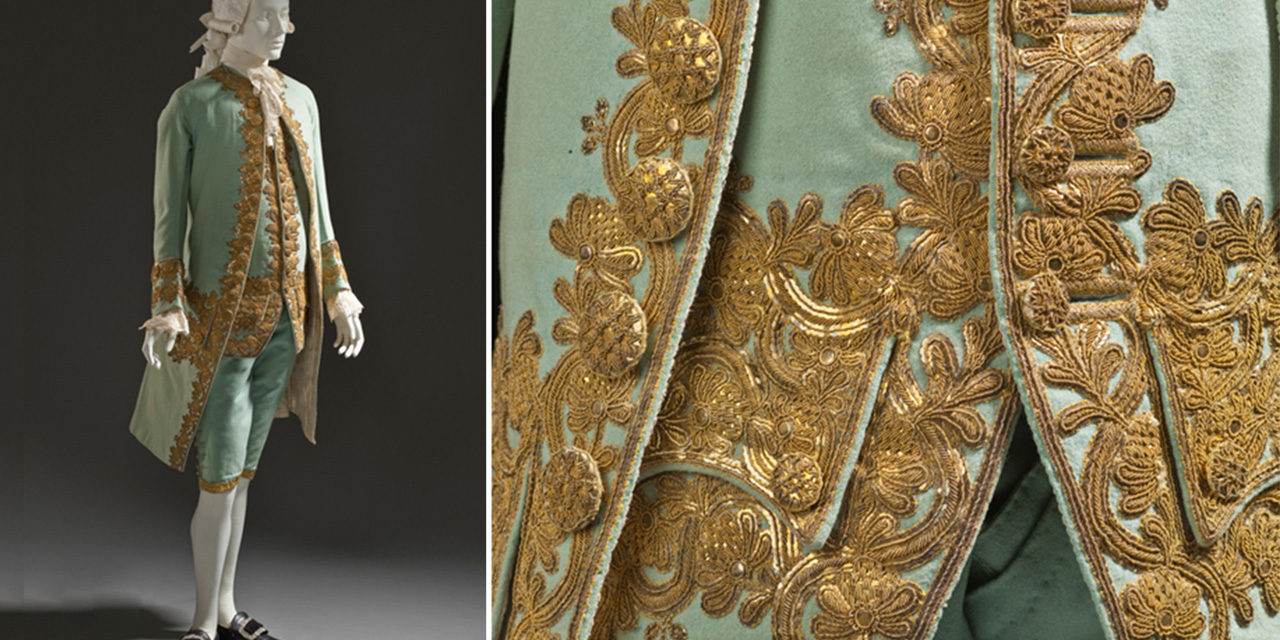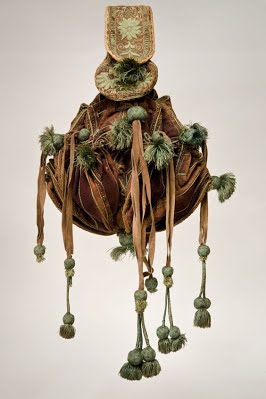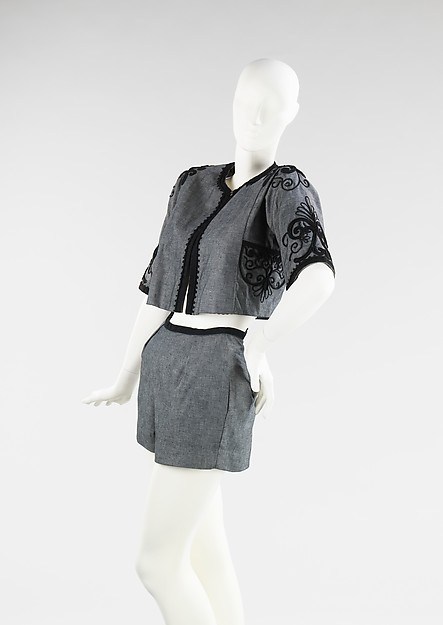An additional accent or embellishment in silk or metallic threads, such as an embroidered braid, tassel or fringe.
The Details
T
he Dictionary of Fashion History (2010) notes that during the 16th-17th centuries passementerie should be defined as:
“Ornamental braids and other trimmings of gold and silver, silk or cotton threads” (262). By the 19th century, it was “colourful braids and fringes decorated with beads, silk and metallic threads” (262).
In The Fairchild Books Dictionary of Fashion (2013), Sandra Keiser and Phyllis Tortora describe the purpose of passementerie, as: “Trimmings, e.g., heavy embroideries, braid tinsel, beads, lace, and gimp, used as edging in 19th c.” (317).
The 18th-century man’s suit with heavy metallic thread embroidery in Figure 1 is a classic example of passementerie used in garments.
The MFA curator describes the passsementerie and detail on Figure 2 as:
“Small, square, heavily-embroidered drawstring bag. Silver metallic threads, wire, metal purl and spangles embroidered on white silk satin ground. Formal stylized floral pattern. Embroidery includes laid couching, raised work, and bullion knots to attach spangles. Two wood-core braided drawstring pulls, braided silk and metallic cords. Three tassels at bottom. Pink silk lining. Several spangles missing; silk split in some areas.”
Fig. 1 - Designer unknown (French). Man's Suit, ca. 1760. Coat and waistcoat: wool plain weave, full finish, with sequins and metallic-thread embroidery; breeches: wool plain weave, full finish, with silk and metallic thread passementerie; coat center back length: 102.235 cm (40 1/4 in). Los Angeles: Los Angeles County Museum of Art, M.2007.211.946a-c. Purchased with funds provided by Suzanne A. Saperstein and Michael and Ellen Michelson, with additional funding from the Costume Council, the Edgerton Foundation, Gail and Gerald Oppenheimer, Maureen H. Shapiro, Grace Tsao, and Lenore and Richard Wayne. Source: LACMA
Fig. 2 - Maker unknown (English). Drawstring bag, ca. 1575-1650. Silk satin embroidered with silver metallic threads, metal purl, wire, and spangles braided silk and metallic cords and tassels; 11 x 11 cm (4 5/16 x 4 5/16 in). Boston: Museum of Fine Arts, 38.1229. Gift of Philip Lehman in memory of his wife Carrie L. Lehman. Source: MFA Boston
Fig. 3 - Maker unknown (Italian, Venice). Falling band (collar) with tassels, ca. 1660-1665. Linen, needle lace; 16.5 x 81.3 cm (6 1/2 x 32 in). New York: Metropolitan Museum of Art, 30.135.152. Gift of Mrs. Edward S. Harkness, 1930. Source: The Met
The mid 17th c. falling band collar shown in Figure 3 is an example of linen needle lace with passementerie tassels.
According to Francois Boucher in 20,000 Years of Fashion: The History of Costume and Personal Adornment (1967):
“the kings of Spain and Portugal had to multiply sumptuary laws curtailing excesses; but when silver and gold embroideries were prohibited (four times, in 1515, 1520, 1523, 1534), embroiderers replaced them with braid and passementeries.” (227)
The Leather pouch in Figure 4 is an example of an accessory with an embroidery made of silk rather than of silver or gold.
Fig. 4 - Maker unknown (German). Leather Pouch with Silk Embroidery, 1604. Leather, silk embroidery. Munich: Bayerisches National Museum. Source: Pinterest
Its Afterlife
Figure 5 shows a playsuit from a 1952 collection “Gold Coast Memos,” by designer Carolyn Schnurer (1908-1998). She was renowned for her culturally-inspired resort collections. The passementerie embroidery on the sleeves and braid trim around the neck and front are directly replicated from a Hausa boy’s jacket which Schnurer documented while in Ghana.
In Fall 2015, Burberry released a sweater coat (Fig. 6) that was featured in Vogue showing a modern use of passementerie via tassels lining the fringe of the garment.
Fig. 5 - Carolyn Schnurer (American, 1908–1998). Beachwear, 1952. Cotton, silk. New York: Metropolitain Museum of Art, 2009.300.166a–c. Brooklyn Museum Costume Collection at The Metropolitan Museum of Art, Gift of the Brooklyn Museum, 2009; Gift of Carolyn Schnurer, 1953. Source: The Met
Fig. 6 - Burberry. Menswear, Fall 2015. Photographer: Marcus Tondo. Source: Vogue
References:
- Boucher, François. 20,000 Years of Fashion: The History of Costume and Personal Adornment. Expanded ed. New York: H.N. Abrams, 1987. http://www.worldcat.org/oclc/777323433.
- Cumming, Valerie, C. Willett Cunnington, Phillis Cunnington, Charles Relly Beard, and C. Willett Cunnington. The Dictionary of Fashion History. Oxford ; New York: Berg, 2010. http://www.worldcat.org/oclc/743409521.
- Davenport, Millia. The Book of Costume. New York: Crown Publishers, 1948. http://www.worldcat.org/oclc/786259658.
- “Passementerie.” Wikipedia, June 25, 2017. https://en.wikipedia.org/w/index.php?title=Passementerie&oldid=787461996.
- Tortora, Phyllis G., Sandra J. Keiser, and Bina Abling. The Fairchild Books Dictionary of Fashion. 4th edition. New York: Fairchild Books, an imprint of Bloomsbury Publishing Inc, 2014. http://www.worldcat.org/oclc/900349357.
















